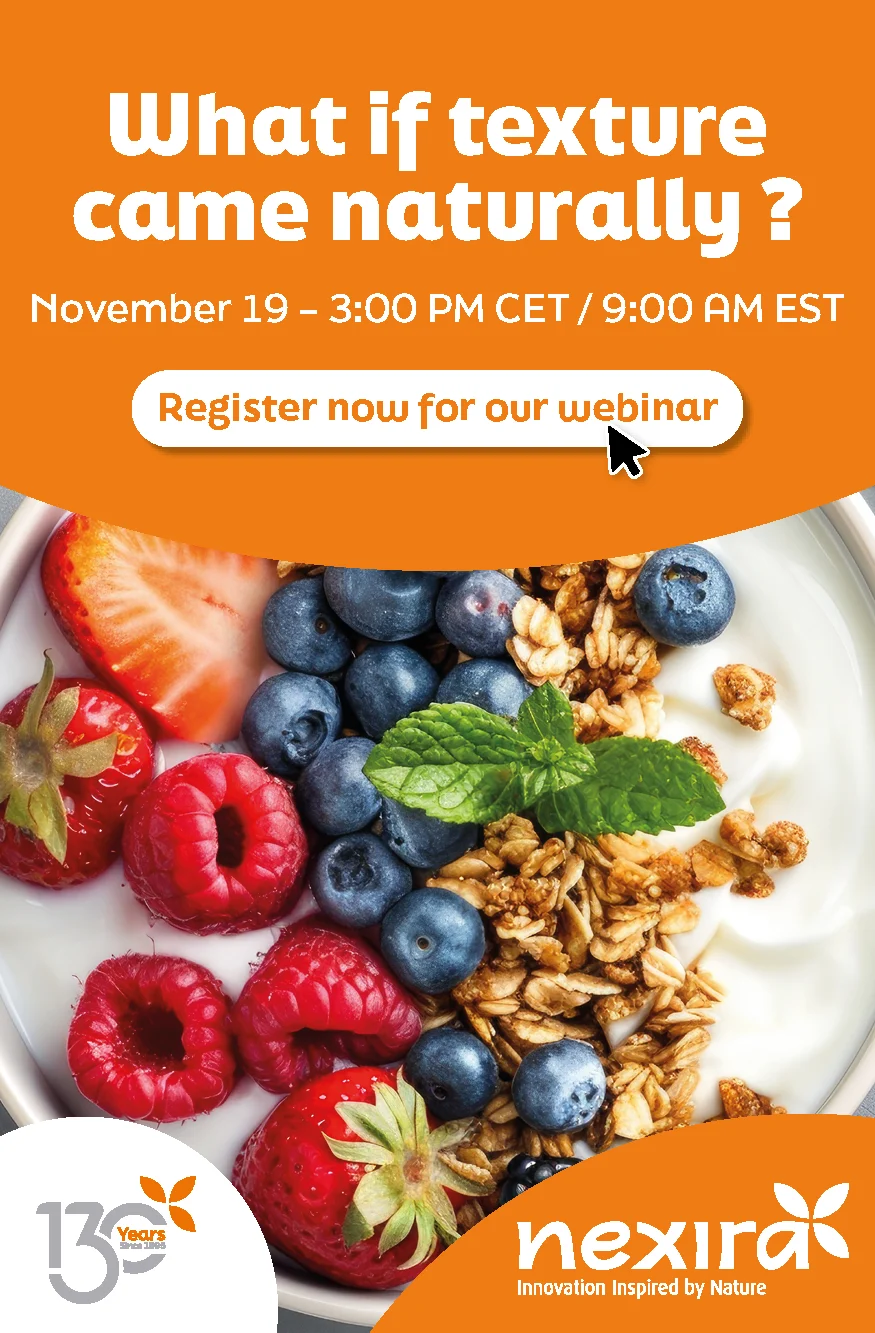Top Ten Food & Drink Trends 2025: Innova Market Insights pinpoints ingredient evolution and digitalization
As the F&B industry heads into a new year, companies and suppliers are identifying the top trends shaping innovation. What are consumers looking for? What are the crucial issues driving food solutions? Many businesses carry out their own research to find out and leverage insights from Innova Market Insights, which spotlights the Top Ten Trends poised to shape the industry every year. We talked to several key players about their predictions for 2025.
Innova’s Top Ten Trends for 2025 crown trend #1 as “Ingredients and Beyond — Elevating Standards,” which is about product differentiation through ingredient quality. The market researcher says this is expected to have a significant impact on F&B next year and beyond as consumers want ingredients with health benefits, nutrition, freshness, shelf life and naturalness.
“As we head into 2025 and brands adjust to evolving regulatory guidelines and consumer definitions of ‘“clean labels,’” formulators must not lose sight of the number one aspect consumers will not compromise on — the sensory experience,” Bastian Hörmann, global marketing director, Sweet Goods, Dairy, Specialized Nutrition, ADM tells Food Ingredients First.

“The food industry is specifically moving away from artificial colors, aligning with regulatory guidelines and consumer demand. Colors and flavors derived from natural sources, quality ingredients, sophisticated technologies and a comprehensive formulation approach can help manufacturers address varying clean label targets and champion taste, texture and appearance.”
Innova’s number two trend is “Health – Precision Wellness,” followed by “Flavors – Wildly Inventive,” “Gut Health – Flourish from Within,” and “Plant-based – Rethinking Plants.”
Prioritizing ingredient quality
Maud Joassard, global marketing manager for Syensqo, agrees the top priority remains natural and clean label ingredients, as supported by consumer preferences and numerous studies and reports.
“Manufacturers and brands are increasingly seeking a variety of claims to meet the broadening consumer demand for clean label products. These claims often include natural ingredients, emphasizing the use of natural, minimally-processed ingredients without artificial additives or preservatives,” she tells us.
 Catering to different quality demands presents new challenges for the industry.Innova data says that 58% of global consumers are prioritizing ingredient quality when making F&B purchases.
Catering to different quality demands presents new challenges for the industry.Innova data says that 58% of global consumers are prioritizing ingredient quality when making F&B purchases.
Dieuwertje Raaijmakers, marketing communications specialist at GNT Group, points out that consumers also want natural, sustainable, healthy and enjoyable food despite the cost-of-living crisis.
“Brands need to find a way to offer products that fit with their target audience’s priorities. There’s always been a strong market for low-cost, high-indulgence treats, but if you want the product to appeal to health-conscious consumers, it’s important for the ingredient list to meet their expectations. Depending on the product, that might mean using natural, plant-based sweeteners, flavors, colors and functional ingredients,” she tells Food Ingredients First.
Many of the important trends we’ve seen across the industry will continue to gain strength.”
Plant-based evolution
Leif Jago, global marketing manager of Food & Beverage, Taste, Nutrition & Health at Symrise, highlights that for 2025 and beyond, health awareness is once again evidently playing an increasingly important role in the naturalness trend.
“This includes a heightened awareness for tasty and clean plant-based options. Expect to see more plant-based options that highlight their concise ingredient lists and use whole ingredients, as health and food security are top purchase drivers for consumers.”
While the plant-based eating revolution is evolving for planetary health reasons, he explains that consumers, especially flexitarians, are turning a more critical eye toward ingredients and production methods.
Innova’s #5 trend for 2025, “Plant-based — Rethinking Plants,” shows that companies are focusing on improving taste and texture while meeting consumer demands for naturalness, health, and environmental benefits, according to the market researcher.
Jago notes there will be an increased demand for plant-based or vegan foods that come with a compelling taste and a clean ingredient list as well as companies focusing on elevating taste experiences of plant-based foods.
“Expect to see a revival of veggies as meat alternatives to replace those that are highly processed. Also, expect to see more options that blend meat with plant-based ingredients and more plant-based options that highlight their concise ingredient lists and use whole ingredients,” he adds.
Improving plant-based taste & texture
Following the waves of plant-based analogs that dominated recent years, consumers now demand a higher bar of plant-based offerings, particularly in taste and texture quality.
They are seeking exciting and sustainable alternative proteins, a diverse range of plant-based options and, crucially, nutritional solutions that have a cleaner label and are subject to fewer processed methods.
“Advanced technologies continue to shape the plant-based sectors; however, challenges remain, especially with the broadening consumer segment interested in various sources of protein. These consumers will not compromise on taste, texture, nutrition or cost, with each critical to the acceptance and adoption of alternative protein formats. Achieving the delicate balance of an exceptional sensory experience with higher protein content and elevated nutritional value is vital to driving the plant-based space forward,” says Hörmann.
“We see opportunities for plant-based with precision fermentation and then plant-based with cell cultivation blends further down the line. Blended and hybrid protein formats may answer calls for a better alternative protein experience without consumers having to drastically change their diets.”
ADM research indicates shoppers are curious about blends, with 63% of consumers across five markets (US, UK, France, Germany and Australia) finding the concept of blended proteins very appealing.
“Whether it’s a combination of different plant-based ingredients or a blend with animal-based proteins, the possibilities with hybrid protein applications are vast and can help ease new consumers into plant-based protein consumption.”
“By pulling from different sources, blends tap into the best characteristics of each ingredient for ideal sensory and nutritional experiences while delivering on protein diversity and addressing cost concerns,” Hörmann adds.
Natural colors for plant-based solutions
The plant-based sector has stalled in recent times. In part, that’s down to cost and sensory qualities, but the health halo has slipped amid concerns around ultra-processing, according to Raaijmakers at GNT.
“There are opportunities to create products that are based around whole plants with the addition of natural flavorings and colors. For example, we developed a ‘parsnip bacon’ concept that uses parsnip slices brushed with a velvety, cold-smoked vegan butter, seasonings and Exberry colors. It has a meaty texture, flavor and appearance and is made using simple ingredients. We made it to inspire brands to reinvent other meat-based classics using vibrantly colored vegetables.”
“Our Exberry colors are made from non-GMO fruits, vegetables and plants and can deliver a complete spectrum of shades in all types of food and drink. It means we can help brands create plant-based products with an appetizing appearance while supporting simple ingredient lists,” she continues.
Food industry and the climate crisis
“Sustainability — Climate Adaption” is Innova’s #6 trend, identifying the connection between consumer awareness of climate change and manufacturers’ sustainability efforts and commitments. Consumers are scrutinizing the environmental impact of their F&B more than ever before. They look for low carbon footprints, energy-saving methods adopted by manufacturers, enhanced animal welfare, good labor practices and brands that are not linked to deforestation or child labor practices, for instance.
This has led to an increase in companies adopting eco-friendly practices such as using novel crop cultivation technologies, regenerative agriculture methods and sustainable packing.
Consumer concerns over the climate crisis are also leading to increased innovation in alternatives of certain commodities and crops hit hard by extreme weather events, supply chain challenges and price volatility.
“When it comes to vanilla, for instance, there is an ongoing crisis that creates significant uncertainties regarding its future availability, quality, and price stability. Most food companies prefer not to deal with such uncertainties and seek alternative, natural and reliable solutions,” says Joassard.
He notes the company’s natural version of its historical vanillin, Rhovanil Natural CW, a natural vanillin is produced through fermentation of a by-product from rice bran oil.
“The raw material is upcycled from rice value chain, is widely available, non-GMO and allergen-free. The Rhovanil Natural range fully complies with both the European and the US regulations for natural flavor, a key labeling for decisions raised by consumers in their purchasing decisions.”
Crippling cocoa prices lead to alt-innovation
Meanwhile, the chocolate and cocoa sectors have seen increased prices throughout 2024, with predictions that the skewed market dynamics will spill into next year.
“There is a growing trend toward chocolate alternatives due to soaring cocoa prices. In this context, vanillin can enhance formulations by boosting certain flavor notes and improving mouthfeel,” Joassard continues.
“Faced with these constraints, F&B players are pushed to innovate while seeing opportunities to develop side markets, capture new growth opportunities and new taste experiences for the pleasure of consumers.”
Digging into digitalization
The last of Innova’s trends for 2025 is trend #10, “AI — Bytes to Bites,” which highlights how brands are beginning to unlock the full power of artificial intelligence. AI is growing in use as a tool for speeding up product innovation, identifying ingredients, developing product formulations, creating flavors, automating production, protecting food safety and supporting sustainability, notes Innova.
Harnessing AI across the value chain extends the possibilities of food production, product development and consumption experiences for ADM. From efficiently analyzing and identifying new microbial strains that support the gut microbiome for personalized nutrition to aiding in market insights to farm sustainability modeling, product design and direct consumer communication, the potential of AI-powered platforms is tremendous, notes Hörmann.
“Further, predictive modeling can help F&B manufacturers craft products tailored to specific health and wellness goals, including the increasing demand for gut microbiome-supporting solutions tailored to the support of sleep quality, mood, weight management, healthy aging and women’s health. There is also an opportunity to combine AI-supported insights with the human touch of expert flavorists, enabling unique multi-sensorial experiences to come to fruition,” he says.
AI disruptions on the horizon in 2025
Also predicting further AI use in 2025 is Jago at Symrise.
“As a megatrend, digitalization permeates all areas of life and creates new preconditions both for consumer nutrition and for F&B brands. Digitalization reshapes the way food gets produced, distributed and consumed. Consumer preferences are changing in a rapidly changing digital landscape, and food is becoming an immersive, engaging and interactive experience.”
“These new technological possibilities are leading to AI-powered F&B innovations. The generation of insights, as well as flavor innovation, has become more efficient and multifaceted thanks to data-driven research. We notice quite a lot of attention in the area of AI. At the same time, we see some value-adding use cases showing the potential of using AI in the F&B industry.”
Jago cites some of the uses of AI including in the personalization trend where AI tailors offerings to customer preferences. In menu optimization where, AI refines menus based on customer data, and in customer service where chatbots enhance customer experiences.
Moreover, it can be used more in nutritional analysis to provide accurate nutritional data and to offer guidance and inspiration for food and beverage innovation. Ultimately, F&B brands can use AI to optimize and expedite product development while also analyzing taste characteristics and flavor combinations.















